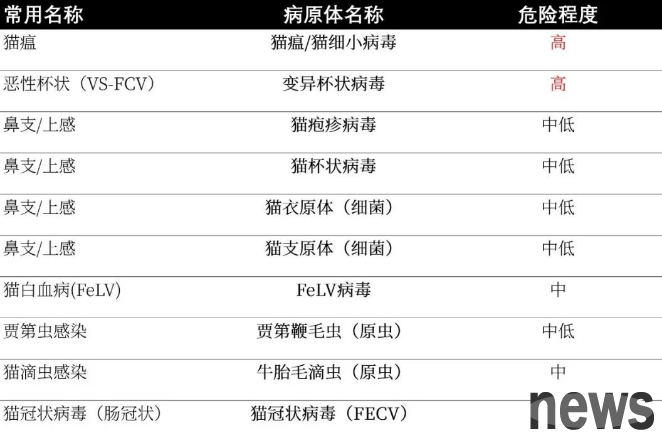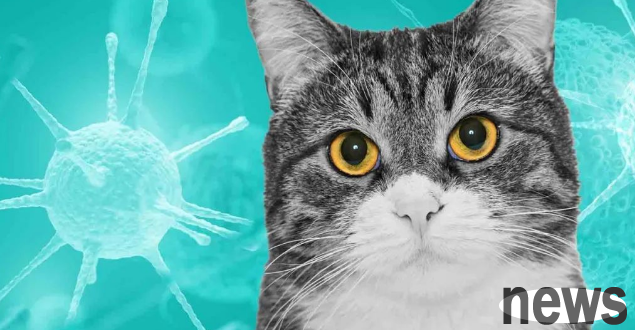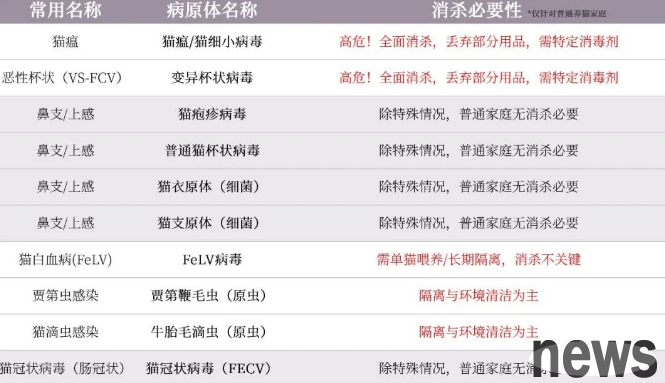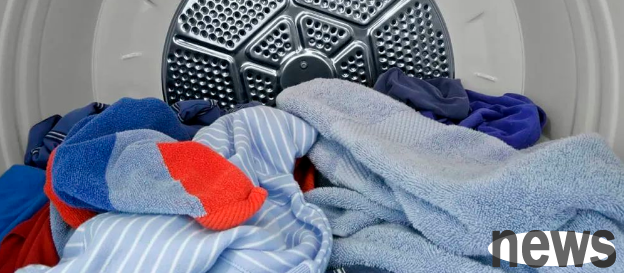Toxic, disinfect, disinfect. When cats enter the family, we either worry about the harm or infection of young cats, or worry about any unknown viruses or bacteria that affect the family. Whenever you keep a cat, you will always have the idea of disinfection.
Just search anyway, there are a lot of special disinfectants for pets, and it seems that each can kill all sides, and there is no difference at all. But do you know? Many disinfectants are unnecessary. Sometimes the correct use of disinfectants is not correct, and it is a waste of time... Our opponents are like human diseases, and they can name them and attract attention. There are thousands of strange things that people can infect; not each of them is worth discussing separately. Among the common cat infectious diseases, the following pathogens are worth paying attention to
In addition to the above pathogens, some "niche pathogens" are not included. Such as feline rotavirus (FRV), feline astrocyte virus (FeAstV), and Cryptosporidium, etc., can all participate in cat acute diarrhea. However, most pet hospitals do not know and cannot conduct screening for these pathogens, nor do they need special disinfectants, and will not be included in the form for the time being.

Disinfection: Do you really need it?
If you have read the table above, you may also have questions about why some viruses are famous, but the danger level is only considered medium-low and medium. This is the next question: how to disinfect is one thing, and whether it is necessary is the prerequisite.
Before making the decision to disinfect, we also need to understand our opponents, the first thing is the cat plague virus that must be disinfected and the most difficult to kill.
Female plague/parativirus (FPLV)
Necessity for disinfection: Among high
cat infectious diseases, cat plague virus is the most difficult to kill. Their environmental survivability and resistance to disinfectants are extremely powerful; most disinfectants are useless at all. When disinfecting cat plague, it is not enough to choose the correct disinfectant. You need to pay attention to the following: The dilution degree of disinfectant cannot be discounted
Disinfectant requires sufficient contact time to kill cat plague virus. Wait for 10-20 minutes after using the disinfectant before cleaning. It is best to wait for it to dry naturally.
Different materials require different disinfection strategies. Some textiles that are difficult to clean thoroughly, such as cat nests, carpets stained with feces are considered encapsulated and discarded.
There is no particularly good choice for fabrics and disinfectants that can kill feline plague viruses (potassium persulfate can be tried, and there is also a chance that it may damage clothes, be careful), but your clothes will indeed be infected with viruses. Clean and dry in time; ironing also has a disinfection effect. If you are infected with the feces of sick numbers and are difficult to clean (such as sweaters), you will consider throwing them away.
It is best to wear white clothes to take care of cats, which are easy to rinse.

Don't forget to physically kill. Dishwashers and dryers above 60 degrees can kill a considerable number of cat plague viruses after heating for more than 30 minutes. They can be used for auxiliary disinfection of clothing and tableware.
Steam mop with sufficient temperature and steam will have some effects, but it can only be used as an auxiliary.
Dryer: I thought it was an IQ tax that costs electricity before buying it. Later I found that it was really good to remove cat hair, and the temperature was enough and it was disinfected - it should not be considered an advertisement, hahahaha
In the survey, we intercepted the common pet disinfectants on websites such as Xiaohongshu, Taobao, etc., as well as daily human disinfectants, including the active ingredients of these products, as follows:
01
Not suitable for cat plague: Quaternary ammonium salts (QACs)
For example, the Anlixia in the table belongs to this category, and the "ammonium" at the end of the ingredients is generally the case.
There are various formulas for this type of disinfectant, and the antivirus ability of different formulas varies; many domestic and foreign families also use this type of product for cat plague disinfection. However, there is currently a lack of evidence that QACs disinfectants can kill cat plague/parativirus. Relevant information unanimously stated that QACs disinfectants cannot effectively kill cat plague virus and have limited effects on cat calicivirus. When you encounter Giardia infection, you can consider using it for environmental disinfection, which is generally not recommended.
For details, see: GUIDELINE for Disinfectant choice in feline vegetable hospitals, shelters and cat households 2015, Quaternary ammonium compounds
02
Can be used: Glutaraldehyde
is also a widely used disinfectant. X5 and Aofujian in the table belong to this category. It is easy to identify. If you look up the ingredients, just see the three words glutaraldehyde (the decanoic ammonium bromide is a quaternary ammonium salt, which is a compound disinfectant). These two brands are not the only ones.
In early studies, glutaraldehyde disinfectants at 2% concentration were sufficiently effective for parvovirus; but in recent years, there are many records that are ineffective against some strains (as follows, ppv is pig parvovirus). It is probably because of the different strains. It can still be considered, with wide antivirus capabilities.
Disinfection efficiency against parvoviruses compared with reference viruses M. Eterpi, et al.2009
Disinfection efficiency against parvoviruses compared with reference viruses M. Eterpi, et al.2009
Disinfection efficiency against parvoviruses compared with reference viruses M. Eterpi, et al.2009
Disinfection efficiency is large? Here is a picture that is concentrated, including cat plague and malignant cup-like disinfection.
03
Can be used: Potassium Bisulfate Complex Salt (DuPont Weike)
Classic old brand, but there were fakes. Maybe it is because its ingredients are too direct and simple, and it is not difficult to imitate.
The main component is potassium bisulfate complex salt, which is configured as a 1% concentration solution. After contacting for 10 minutes, the cat plague virus can be killed.
Don't worry about buying DuPont Weike, just search for potassium bisulfate disinfection powder. This is a very basic disinfectant, which is cheap and large bowls, and 1 kilogram costs more than 50 yuan. It can be configured at a ratio of 1:100 (but this concentration is about 0.5-0.6%, which is also effective).
The powders of this type of product are corrosive. Pay attention to eye protection and wear gloves. It will be better after being configured as liquid, but it will also cause corrosion to some materials. Disinfection ability is good on fabrics and carpets, which is one of the advantages.

is really too cheap...
04
Classics are always passed on: 84 disinfectant (sodium hypochlorite)
After reading three guides and two books, the evaluation of 84 disinfectant, that is, "sodium hypochlorite" and "bleach" is surprisingly unified: the best disinfectant. The ratio is about
1:30 and water is mixed with the ratio. The disinfectant prepared by 84 disinfectant is effective for almost all pathogens, with fast results, simple and economical configuration.
also have disadvantages, which will emit irritating gas during use and require ventilation. It is only suitable for inorganic substances, such as ground, metal countertops, etc., and the effect is not very good when used on organic substances. Be sure to pay attention to distinguishing hypochlorous acid and sodium hypochlorite (84 disinfectant), which are different. Hypochlorous acid (HOCL) itself has a good bactericidal effect, but there is no clinical evidence that it can kill cat plague virus.
Systemic cup/mutant cup (VS-FCV)
Necessity for disinfection: High
Common cat calicivirus mainly infects the respiratory tract, but there is also a mutant cup that can cause serious systemic infection, the main characteristics are ulcers and even necrosis of the limbs and claws, and the liver and blood vessels in the body will be seriously damaged, which is a serious and severe infectious disease.
This cup-shaped mutant strain comes without a trace, and seems to be specifically targeted at vaccinated adult cats. It can be treated with drugs for cat infectious peritonitis. Complete environmental disinfection is required. See the table above for specific disinfection plans.
The following are pathogens that have low significance in home environment disinfection or require other strategies to prevent.

Female Herpes Virus & Cat respiratory cup
Necessity for disinfection: Low
According to back-end and daily consultation statistics, these two viruses rank among the top three in "disinfection panic". Many cat friends are panicked beyond the actual situation and are too afraid of these two viruses; let's write a few more words.
cat herpes (FHV-1) and ordinary cat cup (FCV) are not very tenacious in the in vitro environment. Their transmission strategy is not like cat plague and canine parvovirus, which is difficult to kill with full points of defense. On the contrary, the skill point sneaks up.
After cats are infected with herpes and calicivirus, it is difficult to completely remove these two viruses from the body. After the acute infection period, the virus enters a very long-term latent state, which can not cause any abnormality (subclinical infection) or even PCR testing may not be detected; during this period, it may be intermittent and asymptomatic detoxification. I looked at the cat that has always been very good, but I actually had it been infected.
The author's attitude towards adult cats is: regardless of whether there are or not, it is not enough to have been infected with herpes or cups by default. This is not the end. The cat triple vaccine can only alleviate the symptoms related to infection and cannot be completely immunized. This infection is the same as infection. Faced with this situation, the effect of environmental disinfection is very limited. What needs to be done is to isolate kittens who are not properly immunized (<16 weeks old, those who have not been vaccinated after 16 weeks of age are considered high-risk and need to be properly isolated).
If a cat has been injected with the full set of cat triple vaccine and will live with other cats for a long time in the future, the value of disinfecting cat herpes and calicivirus is very low.
The reason is also mentioned above: it will eventually be infected without realizing it. Instead of working hard on disinfection, it is better to make psychological preparations and knowledge reserves to deal with acute infections and recurrences. These two viruses are not that scary.
Defense strategy for high-risk kittens
The first priority is to completely isolate other cats and maintain a distance of at least 3-4 meters stably; it is best to separate two houses until the entire set of vaccine injection is completed. In particular, you need to pay attention to the replacement of clothes. Perhaps disposable protective clothing is a good idea.
The last is environmental disinfection, just use ordinary cleaning supplies. The feline herpes virus is very fragile in the environment. Please refer to the table above for cup-like disinfection.
The hazards of cat herpes? There are many extreme cases
because the base is too large. In fact, it can be said that there is no harm. It is often a few days of sneezing and tears, and it will be cured quickly with some antibiotics.
Most cats are infected with herpes virus and will not face any serious situations. The main causes of the symptoms are various bacteria, not viruses. Even in recent clinical studies, it has been found that there is no big difference between using antiviral drugs when treating nasal brachial/superia.
The hazards of cat cup-shaped?
Cats are much more blamed on cup-shaped shoulders than herpes. In fact, it is not that exaggerated. Usually the symptoms are low fever, sneezing, and eye inflammation caused by some other pathogens. The treatment plan, like herpes, mainly relies on antibiotics to deal with bacterial infections, and generally does not use antiviral drugs. A common special case is that after cupic infection, some cats will limp for a short time and can heal themselves.
According to statistics, most cats still detoxify after being infected with goblets. There are also many cases of asymptomatic detoxification; this has created a very high infection rate in cat groups. Similar to herpes, the more cats, the higher the positive rate. More than 4 cats can reach a positive rate of more than 32%-90% (it may not be detected during the non-detoxification period).
As for cup shape and stomatitis concerns? In past experiments, cupic infection only caused acute stomatitis in specific cats, and soon self-healing (SPF cats, a specially bred experimental subject) did not have this effect on ordinary cats. Not to mention, this acute stomatitis is not the same as the chronic stomatitis we encounter.
In short, cup shape is related to chronic stomatitis in cats (the essence of stomatitis is a hypersensitivity to single and multiple viruses). However, correlation ≠causality. The prevalence of cat stomatitis is also much lower than that of cat cups. Do not regard cups and cat stomatitis as a causal relationship..
Welcome to check the old article: The Trouble of Cat Raising a Cat | Can cats carry calicivirus? Necessity for disinfection of
Fe Leukemia Virus (FeLV)
: About 30% of the positive cats with a low of
will spread live viruses and infect other cats. The body fluids are poisonous and spread by contact. The main prevention method is to completely isolate the sick cat and eliminate the possibility of contact.
Environmental disinfection is not very meaningful, and ordinary soap is enough for daily cleaning. The reason is that feline leukemia virus (FeLV) has extremely weak viability in the environment in vitro and will die naturally within a few minutes without intervention. (The same is true for cat AIDS FIV virus, deliberate environmental disinfection is not high)
Kirks Current Veterinary Therapy XV CHAPTER 272, cat retrovirus
cat coronavirus (enteric coronavirus, FECV)
disinfection necessity: low
, and almost all cats have intestinal coronary virus (FCOV/FECV). A considerable number of cats are infected from female cats. A few kittens have diarrhea, vomiting, and low fever after infection, but most of them have no abnormalities at all and are not very pathogenic (or almost nothing? See Gingrich et al, 2010). The coronavirus is diagnosed with a cat's stomach tummy, because this virus is too common, just joining in the fun, not because the coronavirus caused the disease.
The fear of cat coronavirus is mainly due to cat infectious peritonitis (FIP). The word "infectious" is a historical issue, which has brought about a lot of misunderstandings. Although cat coronavirus is involved in this disease, the veterinary medicine community does not believe that FIP can be contagious. The occurrence of this disease requires the integration of the special nature of the cat's immune system, gene susceptibility, and viral mutation. It does not rely on infection and cannot be considered an infectious disease.
For detailed discussion, please read the old article: Is it really not contagious for cats? Should I panic if a cat coronary (FECV) is positive?
In summary, there are too many prerequisites for cat intestinal coronavirus to cause disease, and there is no possibility of complete killing, and there is no need for special disinfection.
Giardia
Necessity for disinfection: Low ?
The large family belongs to protozoa and can cause diarrhea in cats. Generally, special disinfectants are not required. Isolate from cats under 2 years old, eliminate drinking raw water, use commonly used cleaning supplies to clean the home, and solve sanitary blind spots. A bath for a sick cat can also help control transmission (don't wash too much, cats don't like it).
mainly relies on isolation and basic environmental cleaning. If you have any concerns, you can use quaternary ammonium disinfectants to clean the environment.
Chericidal necessity for cow fetal trichomonas
: Low ? As can be seen from the name
, this is a protozoa that mainly infects cattle. However, a large number of cats are also infected worldwide. It can cause stubborn diarrhea in cats, with few drug choices and a long treatment cycle. This kind of trichomonas has a long history of infecting cats, but no one knows how it emerges. Is it caused by mosquitoes? But the media of communication is not sure.
mainly relies on isolation and basic environmental cleaning. If you have any concerns, you can use quaternary ammonium salt disinfectants (one search and one large handful) for environmental cleaning.
FAQ
For cat-raising families, is it necessary to disinfect them regularly?
Answer: It is recommended that there be foreign cats, such as disinfection when rescuing a wandering place. Daily disinfection is not as valuable as expected, and I will not do it either. It is more important to clean daily, sweep the floor and mop the floor, clean cat toilets and food basins, and avoid sanitary blind spots.
Are you sure that disinfecting the herpes virus is not required?
Answer: It doesn't make much sense. If you still want to disinfect it, basic disinfectants, even soap and dishwashing liquid can kill herpes virus. What about the cup shape? Not needed?
Answer: It is difficult to control and prevent infection through disinfection for a long time, unless all cats are isolated for a long time. Personally, I think it is still cost-effective to disinfect and isolate milk cats and kittens. In other cases, just accept the fact that this virus is very common, don’t scare yourself.
Is there any disinfectant that is less irritating and more suitable for daily use?
Answer: Then use hypochlorous acid disinfectant (buy whatever you want), which is good to kill common bacteria, but it cannot deal with stubborn viruses. It is good to use it in daily life. It is OK to clean cat toilets and tableware, and the skin is not very irritating.
I heard that 84 disinfectant is poisonous to cats?
Answer: Dilution at an appropriate concentration is not toxic, it will release irritating gases, it requires ventilation; it is still a very useful and comprehensive disinfectant.
Dilu and Vilushi are completely useless?
Answer: It is not recommended to use it. It is best to stay away from the cat if any ingredient is "phenol". Because cats lack UGT enzymes, they will be poisoned if they cannot metabolize. But don’t panic too much. I haven’t seen cases of chronic poisoning in China. Acute poisoning requires direct contamination and licking disinfectant.
If I want to keep strong disinfectants, what should I prepare?
Answer: Potassium bisulfate compound salt powder; just mix water according to the instructions when using it. It is cheap and easy to use and has strong killing ability, and it also has a disinfection effect on textiles. But it is also a bit corrosive, don't hurt furniture at once.

Is it necessary to spray and disinfect the cat?
Answer: It is not necessary. A strong disinfectant that can kill stubborn viruses will inevitably have irritation and is not suitable for direct use on the body. If you encounter coccidius, trichomonas, and Giardia infection, you can take a bath; as for whether the cat itself will "infect" something for people, it is necessary to know that the surface of our humans and animals is full of bacteria and cannot be killed. Pet cats carry zoonotic diseases that are not as many as you imagined.
Postscript
This article mainly wants everyone to appropriately let go of their obsession with disinfection. Many times, disinfection is a bit like bathing a cat. There are actually more psychological needs. The longer you keep a cat, the less you can remember it.
On the other hand, a stubborn and dangerous virus like cat plague also needs to explain clearly what disinfectants are useful and what are useless. There are also some viruses that everyone thinks are very dangerous and want to prevent, but the disinfection effect is limited because cats detoxify from time to time (herpes, cup shape).
During the investigation, it was found that many cat parents still used it to deal with cat plague by "just to catch a pet". Maybe even the manufacturer itself couldn't tell how effective this was, so they wrote a few more. The space is limited, some fungi and Bacillus have not been involved, and some disinfection methods have not been fully analyzed. I hope it will be helpful to everyone. If you have any questions, please leave a message.
